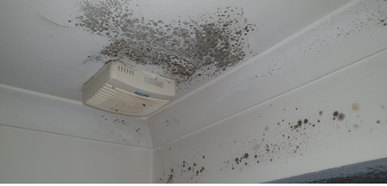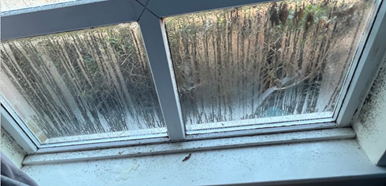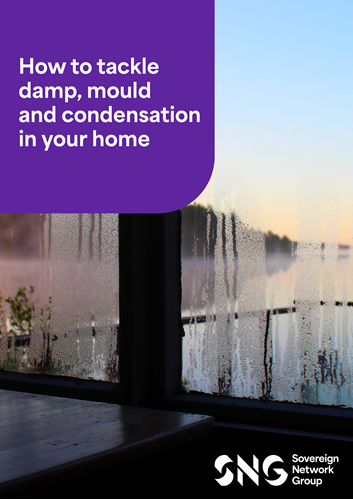Condensation, damp and mould
Too much moisture in your home can lead to damp and mould which can give rise to a range of problems. For example, it can look unsightly and cause damage to your walls, decorations, and furnishings. Mould can also affect some people’s health. It is therefore important to work together to manage excess moisture in your home, and to act early to avoid the situation getting worse.
What causes damp?
Damp is caused when there’s excess moisture in the air that has no way to escape. Excess moisture can enter your home in several ways and the most common causes are from condensation and penetrative or rising damp. Cold walls can also encourage damp to develop within your home. If too much moisture builds up and is left untreated, mould may start to grow.
Penetrative or rising damp
- Rain can get in through leaking roofs, blocked or damaged guttering, leaky walls and poorly fitting doors and windows. This is known as penetrative damp. This can also be caused by plumbing leaks, issues with appliances and damaged seals on baths and showers. In these instances, moisture can quickly build up, often in places you cannot see.
- Ground water can rise through the walls and floor if the damp proof course isn’t working properly or is missing. This is known as rising damp.
- Mould can occur on walls when warm air settles on cold walls (pictured below) and this can also then cause damp.
 To help us maintain your home and reduce damage caused if any of these damp issues arise, we recommend regularly checking your home for leaking pipes, water stains and mould on ceilings and walls caused by water penetration through roofs and/or window frames. If you spot the signs of penetrative damp or rising damp, please report this to us.
To help us maintain your home and reduce damage caused if any of these damp issues arise, we recommend regularly checking your home for leaking pipes, water stains and mould on ceilings and walls caused by water penetration through roofs and/or window frames. If you spot the signs of penetrative damp or rising damp, please report this to us.
Condensation
 Condensation occurs when warm, moist air, such as steam from a kettle, comes into contact with cool air or a cool surface, such as windowpanes (pictured right). Water droplets form when the cool air or surface reduces the temperature of the warm, moist air, turning it from gas to liquid.
Condensation occurs when warm, moist air, such as steam from a kettle, comes into contact with cool air or a cool surface, such as windowpanes (pictured right). Water droplets form when the cool air or surface reduces the temperature of the warm, moist air, turning it from gas to liquid.
We all add moisture to the air, just by breathing and doing everyday activities such as cooking and drying clothes. Our pets and house plants also add moisture to the air. If too much moisture builds up, mould may start to grow on furniture, cold ceilings, walls, around windows and in the places where air doesn’t circulate well. The common areas for condensation are the kitchen, the bathroom and the bedroom.
Reducing moisture in your home
If you follow the tips below, you can reduce excess moisture that can lead to mould in your home.
Some ordinary daily activities can produce a lot of moisture very quickly, here are some tips to produce less moisture:
- Cover pans when cooking and do not leave kettles boiling. Ensure windows are open or extractor fans are on.
- Avoid using paraffin and portable bottled gas heaters as these produce a lot of moisture in the air.
- Avoid drying washing on your radiators, or if you do then dry it in the bathroom with the door closed and the window open.
- Ensure that tumble dryers with a vent tube are vented to the outside. If you have a condensing dryer, ensure any windows in the room are open.
- Improve the overall ventilation in your home by keeping a small window open when someone is in the room.
- If your windows have trickle vents, keep them open as much as possible.
- Do not draught-proof windows in the bathroom and kitchen.
- Ventilate kitchens and bathrooms when in use by opening the windows wider, or better still, use the electric fan if you have one.
- Close the kitchen and bathroom doors when they are are in use. This will help prevent moisture reaching other rooms, especially bedrooms, which are often colder and more likely to get condensation.
- Put a small amount of cold water in the bath before you turn on the hot tap.
- Ventilate your bedroom well at night (ensure a window or door to your room is left slightly open and air vents are left open).
- Do not block air-brick vents or ventilators.
- Ventilate cupboards and wardrobes and avoid putting too many things in cupboards.
- Place furniture slightly away from the wall. Where possible, position wardrobes and furniture against internal walls.
- Keep the temperature of your home above 15 degrees Celsius in all rooms with heating.
- Do not run your shower for longer than needed. This reduces moisture and will also save energy.
- Wipe down condensation or water (including on window ledges and sills) with a cloth every morning, and ensure it is wrung out and dried properly between use
The earlier you treat mould, the better. If black mould does appear, treat the mould first, and then deal with any excess moisture issues to stop the mould reappearing.
Treating mould that appears on surfaces in your home is straightforward:
- Wipe down or spray walls and window frames with a fungicidal wash which carries a Health and Safety Executive approval number – available from most supermarkets. Please make sure you follow the instructions for safe use.
- After treatment, redecorate using fungicidal paint and a fungicidal-resistant wallpaper paste to help prevent mould recurring.
If you can say ‘yes’ to all the following questions, you’ll be helping to reduce condensation and avoiding damp and mould in your home
- Do you cover saucepans with a lid when cooking?
- Do you open a window in your kitchen to allow water vapour to escape when you're cooking?
- Do you dry your washing outside in the fresh air when you can?
- Is your extractor fan working and switched on?
- If you use a tumble dryer, is it properly vented to the outside, or is the window open in the room it is in?
- Is your bedroom well ventilated at night? (a window left slightly open or the door to your room left ajar and air vents left open?)
- Can air circulate freely between your furniture and the walls?
- Do you keep your heating on low all day when it is cold?
- Are the airbricks open and not blocked by furniture or other items?
If you have a damp or mould issue in your home that is caused by water penetration, or if you follow our condensation tips and the situation does not improve, please contact our Customer Service Centre. We can then look into this and work with you to resolve the issue.
You can contact us by:
- emailing us at customerservice@networkhomes.org.uk
- tweeting us at @asknetworkhomes or @networkhomesuk, or messaging us on Facebook at @networkhomesuk from Monday to Friday from 10am to 3pm
- reporting a repair using My Network Homes, your online account with us
- completing a contact us form on our website
- calling us on 0300 373 3000.
Need more information?
Watch our video guide to preventing condensation and mould
The information on this page is also available to read as resident leaflet. You can download and read the 'How to tackle damp, mould and condensation in your home' leaflet by clicking here or clicking the image below.
If you need to translate this information into a different language, or use audio or visual tools to adapt this information to your needs, you can access a wide range of these tools and services by selecting the 'Me Accessibility' button at the top of this page which looks like this:



